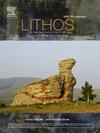Rejuvenation of a granitic magma reservoir by mafic injections: Evidence from zircon UPb geochronology, Hf isotopes and trace element compositions (Porto complex, Western Corsica)
IF 2.9
2区 地球科学
Q2 GEOCHEMISTRY & GEOPHYSICS
引用次数: 0
Abstract
The Porto complex (western Corsica, France) is a post-Variscan, shallow-level intrusive system where mafic and felsic rocks are closely associated. To assess the timeframe and impact of successive injections of mantle-derived melts on a granite magma reservoir and gain a better understanding on the evolution of the complex, we performed high precision U![]() Pb dating combined with trace element and Hf isotope compositions of zircon separated from both mafic intrusives and associated granites.
Pb dating combined with trace element and Hf isotope compositions of zircon separated from both mafic intrusives and associated granites.
Zircons from the granites have similar 206Pb/238U ages and initial Hf isotopic compositions. The saturation of zircon in the felsic magma occurred before emplacement and mingling with the mafic magma, between 282.55 ± 0.28 Ma and 281.65 ± 0.42 Ma, and at ∼800 °C. The initial ɛHf values of zircons (3.7 ± 2.0 to 5.3 ± 1.0) indicates that the felsic magma source experienced addition of crustal material to a mantle component. Interaction with late-hydrothermal fluids, most likely related to an event affecting the Porto complex after its emplacement, was responsible for the modification of LREE, Ti, Fe and Mn compositions in zircons affected by intense metamictization.
Zircons from the mafic rocks have slightly enriched initial ɛHf values (5.7 ± 1.6 to 6.9 ± 1.6) relative to depleted mantle composition. U![]() Pb zircon dating identified two chronologically distinct mafic melts injections, at 280.93 ± 0.21 Ma and 279.63 ± 0.15 Ma, which are representative of the time of mafic magma emplacement and mingling with the felsic magma.
Pb zircon dating identified two chronologically distinct mafic melts injections, at 280.93 ± 0.21 Ma and 279.63 ± 0.15 Ma, which are representative of the time of mafic magma emplacement and mingling with the felsic magma.
To explain the long-time interval occurring between the saturation of zircon in the felsic magma and the time the granite emplaced, mingled and crossed its solidus, we propose that during cooling, the zircon-bearing granite magma reservoir was intruded, most likely at the base of the felsic mush, by injections of hotter, mafic magmas that caused at least two successive events of rejuvenation and remobilization, which promoted the shallow intrusion of variably differentiated felsic magmas.
求助全文
约1分钟内获得全文
求助全文
来源期刊

Lithos
地学-地球化学与地球物理
CiteScore
6.80
自引率
11.40%
发文量
286
审稿时长
3.5 months
期刊介绍:
Lithos publishes original research papers on the petrology, geochemistry and petrogenesis of igneous and metamorphic rocks. Papers on mineralogy/mineral physics related to petrology and petrogenetic problems are also welcomed.
 求助内容:
求助内容: 应助结果提醒方式:
应助结果提醒方式:


